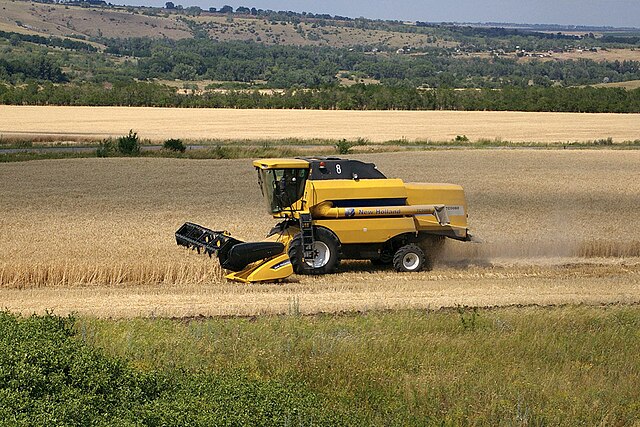Agriculture in Russia is an important part of the economy of the Russian Federation. The agricultural sector survived a severe transition decline in the early 1990s as it struggled to transform from a command economy to a market-oriented system. Following the breakup of the Soviet Union in 1991, large collective and state farms – the backbone of Soviet agriculture – had to contend with the sudden loss of state-guaranteed marketing and supply channels and a changing legal environment that created pressure for reorganization and restructuring. In less than ten years, livestock inventories declined by half, pulling down demand for feed grains, and the area planted to grains dropped by 25%.
Farming machinery plant (Moscow region, July 2019)
A combine in the Rostov Oblast.
A typical household plot in Fedyakovo, near Nizhny Novgorod
Young wheat just coming up in June in a field near Nizhny Novgorod
Agriculture in the Soviet Union
Agriculture in the Soviet Union was mostly collectivized, with some limited cultivation of private plots. It is often viewed as one of the more inefficient sectors of the economy of the Soviet Union. A number of food taxes were introduced in the early Soviet period despite the Decree on Land that immediately followed the October Revolution. The forced collectivization and class war against "kulaks" under Stalinism greatly disrupted farm output in the 1920s and 1930s, contributing to the Soviet famine of 1932–33. A system of state and collective farms, known as sovkhozes and kolkhozes, respectively, placed the rural population in a system intended to be unprecedentedly productive and fair but which turned out to be chronically inefficient and lacking in fairness. Under the administrations of Nikita Khrushchev, Leonid Brezhnev, and Mikhail Gorbachev, many reforms were enacted as attempts to defray the inefficiencies of the Stalinist agricultural system. However, Marxist–Leninist ideology did not allow for any substantial amount of market mechanism to coexist alongside central planning, so the private plot fraction of Soviet agriculture, which was its most productive, remained confined to a limited role. Throughout its later decades the Soviet Union never stopped using substantial portions of the precious metals mined each year in Siberia to pay for grain imports, which has been taken by various authors as an economic indicator showing that the country's agriculture was never as successful as it ought to have been. The real numbers, however, were treated as state secrets at the time, so accurate analysis of the sector's performance was limited outside the USSR and nearly impossible to assemble within its borders. However, Soviet citizens as consumers were familiar with the fact that foods, especially meats, were often noticeably scarce, to the point that not lack of money so much as lack of things to buy with it was the limiting factor in their standard of living.

1954 stamp depicting potato planting
Trotsky and Left Opposition supported an alternative programme to Stalin which proposed a voluntary tax-based approach to collectivization.
Soviet Union stamp, the seven-year plan, grain; 1959, 20 kop., used, CPA No. 2345.
Vladimir Krikhatsky's The First Tractor presents a Socialist view of country mechanization.








